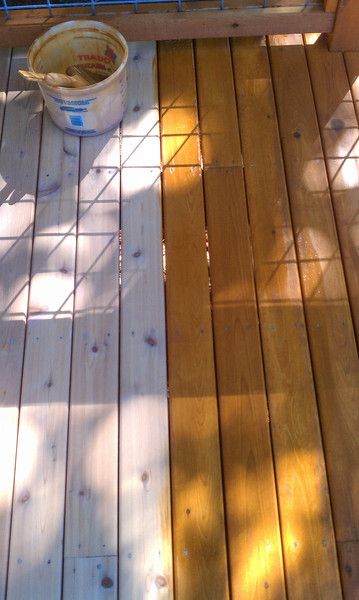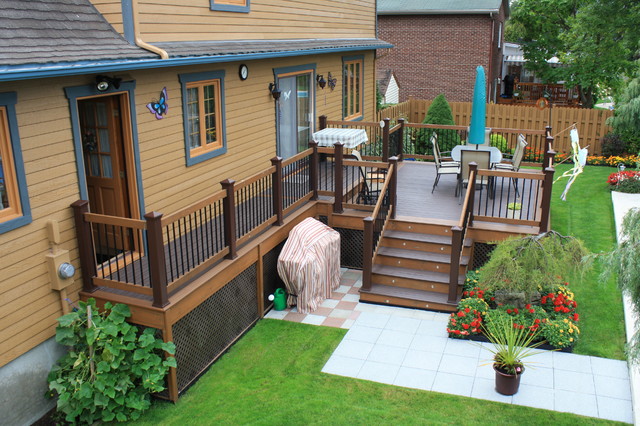Choosing the Best Deck Stain and Sealer for Kansas City Decks
What is the best stain for your deck?
Wading through the myriad of available stains can be overwhelming. Do you choose oil-based? Alkyds? Water-based? Penetrating or film-forming?
How important is a low-maintenance deck?
Selecting the right stain for your decks micro-climate is also important. Does you deck sit in shade or sun? Does it tend to grow mold? All these variables count when selecting the best deck stain for your deck.
If after reading this article, if you still have questions. Feel free to contact us for additional advise.
Home » Choosing the Best Deck Stain and Sealer
Choosing the Best Deck Stain and Sealer for Kansas City Decks
Best Deck Stain: The Basics for Decks located in Kansas City, Missouri
Stain Pigmentation
There are four basic types of deck finishes: solid, semi-solid, semi-transparent and clear stains. The main difference between each one, is the amount of pigmentation they contain. From a solid stain to a clear sealer you will find less and less pigmentation. The pigmentation is finely ground particles that are designed to add color and block the surface from UV rays and prevent the natural graying that the sun will cause.
Clear Sealers

These stain really don’t stain as there is no pigmentation for the wood to absorb. Sealers “seal” the wood from the elements and typically last a year or two. After that you need to re-coat. These sealers are easy to apply and makes your maintenance quicker and easier, but they require more frequent application.
Sealers come in either water or oil-based formulation. They may contain a few ingredients to absorb the suns UV rays, but do not block them as there are no pigments that could block them.
Besides the ease of application, clear finishes allow the natural wood grain to show through. This can be appealing with cedar and redwood decking, but consider a semi-transparent stain that still allow the wood grain to show through.
Semi-Transparent Stains
The next step on the gradient of increasing opacity are the semi-transparent stains. They are sometimes called toners.

These stains contain UV blocking pigments that offer more protection from UV damage and they are clear enough to allow most of the wood grain to show. Indeed, semi-transparent stains enhance the grain. These stains come in a variety of colors and tones. Re-coating your deck depends on several variable including sun exposure, foot traffic and the weather in your area. And as we all know, the weather in Kansas City can sometimes be brutal. Horizontal surface requires the most maintenance and you can count on 2-3 years before you need to re-apply.
Horizontal surfaces include the deck surface you walk on as well as the top of the hand rail. This extra time between coats decreases the maintenance cycle over clear sealers, but potentially increases the difficulty of refinishing the surfaces due to the pigments that remain on the surface.
Many stains call for a removal of previous coatings before applying the new stain. This is especially true when switching from one brand of stain to another. Depending on exposure to the weather and the stains age, a wood cleaner may remove some semitransparent stains. However, in other cases a stain stripper (like a paint stripper) is more effective as well as more difficult.
Stain strippers will soften and partially dissolve most semitransparent deck stains so they can be rinsed, scrubbed away, or pressure washed away. Semi-solid and solid stains may take multiple applications of the strippers and some sanding in corners and tough to reach areas. A stripper will also clean your deck at the same time, so it’s not necessary to use a deck cleaner after stripping.
Pro Tip A good way to test if you need to use a stripper is by using the absorption test. Pour a small amount of water on the decking in high traffic areas as well as the low-traffic areas. If the water beads up, then too much stain or sealer is present, and you will need to strip it. However, if the water begins to absorb into the wood within 5-10 minutes, then the coating has worn off enough that you can re-stain or re-seal the decking. But beware of applying a lighter color stain over any darker remaining pigments. If they are not removed by cleaning or stripping, they may show through, leaving a blotchy appearance.
Since many semi-transparent stains soak into the grains of the wood, they last longer than most clear sealers and provide stronger protection against the elements. Also, due to their ingredients, they are much less likely to crack and peel off the deck surface.
Semi-Solid and Solid Stains

The most opaque finishes include the semisolid and solid stains. Each contain a lot of pigmentation, and pigmentation is what blocks UV rays. Both of these stains come in a wide range of colors that can spruce up the uniformity of old pressure treated decking. These stains last longer than the others — up to five to eight years —So you may be thinking that solid or a semi-solid stains are best option. However, many of the solid stains are basically a water based or oil-based paint, and paints on horizontal surfaces do not hold up well.
There are a few problems with semisolid and solid finishes. In many cases, depending on your skill level, they may show brush marks when the surfaces do not dry evenly. The best advice is to apply the finish on just a few of deck boards at a time, following them from one end to the other, always keeping a wet edge, and then move on to the next section.
Semisolid and solids will make wear patterns on the deck more obvious, and they require the most prep work before they can be recoated. Sometimes, the manufacturer may recommend that the surface be stripped before any new finish is applied. Semisolid stains do offer more protection for a longer period of time, but they’re harder to apply evenly and require more work during the preparation. They will eventually chip, flake, and wear off on horizontal surfaces due to traffic and exposure to weather
Solid Stains – Should you avoid Film-Forming Finishes?
A solid stain is basically a type of paint that is typically thinner than ordinary exterior paint. Remember, All paints form a film designed to block sun and water for long stretches of time. This attribute make paint the ideal coating for your vertical surfaces like exterior trim and siding. But solid stains are not an advantage for the horizontal deck surfaces. Foot traffic wears through the stain and the freeze/thaw cycle loosens and cracks the finish. It begins to bubble and chip away, leaving a less than ideal look to your deck. A penetrating deck stain is designed to protect you deck without forming a film.

Film-forming stains and paints develop hairline cracks over time. When they do, rain gets beneath the film and stays there. That means there is a perfect environment for bacteria and mold underneath the “paint”. Bacteria and mold lead to decay and rot. Additionally, when the water freezes, it expands and the cracks turn into chips that expose the surface to additional exposure from the elements.
Highly opaque solid deck stains can be paint-like in this respect. Homeowners sometimes take a look at the result of the first coat and think the deck needs multiple coats. Yet when they try to make the surface of the deck look as uniform as a freshly painted wall by applying more finish, the stain morphs into a film-forming finish (paint).
Two-Tone Decks

Many people are choosing to finish their decks with a two-tone scheme where the deck vertical surfaces like balusters/spindles, posts and other vertical portions of the deck are coated with semi-solid or solid stain, while the horizontal surfaces are coated with a penetrating sealer or semi-transparent stain. The vertical surfaces don’t take the same amount of punishment as the horizontal surfaces and the semi-solid or solid stain last longer and still look good on vertical surfaces. This reduces your maintenance cycle for the verticals. You still have a more frequent cycle with the horizontals, but there is less area to cover. One downside is that it’s a more tedious application process as you need to cut in your decking surface around your posts and other areas by hand.
Oil or Water-Based Stain?
For many reasons, acrylic latex paint has gradually replaced traditional oil-based formulations, and manufacturers are showing equal resolve in developing water-based deck finishes. There have been steady improvements in their durability.
Some say that water-based finishes can be as durable as oil-based. Water-based finishes wear differently than oil-based penetrating stains. Like solid stains, they tend to eventually flake and peel away. Also, when it comes time to refinish, water-based stains are more likely to require stripping the deck to bare wood. Strippers that can remove water-based finishes are becoming more and more available, but when tackling a deck that’s been finished with a water-based product you may need to sand before applying the new finish.
Oil-Based Stain
Linseed and soy oils have been traditional choices by manufactures when producing oil-based stains. They apply easily and they penetrate deeper than water-based coatings and they wear gradually due to traffic and never chip and peel.
However, natural oils have some disadvantages: First, these stains contain more VOC’s than water-based coatings do — and VOC’s (volatile organic compounds) that are falling under government regulations in many states.
Second, natural oil can become food for mold. In the right environment, moist, warm, and not a lot of sunlight, mold can thrive. If you deck is situated in a similar environment, consider adding a fungicide to the mix to control that potential problem.
Also, consider using modified oils or Alkyds. They don’t have the same potential for mold growth. Alkyds are more expensive than natural oils, but make up for that by curing faster and lasting longer.
No Definitive Answer
If you’re looking for the single best deck finish, one that works on every deck in all situation, not matter what, then you will be frustrated. Believe me, I’ve been there. But weighing the pro and cons of each type of finish, acceptable maintenance levels, and comparing that to your individual deck situation (sun, shade, freeze/thaw, and other exposure considerations) will help you choose the best stain for your deck. Should you need some assistance, please reach out.
Call Now For Immediate Service (816) 490-7671
Kansas City – Deck & Fence Pressure Washing, Cleaning, and Restoration
Copyright 2018
(816) 490-7671
Website and Content by: Nexes Digital
